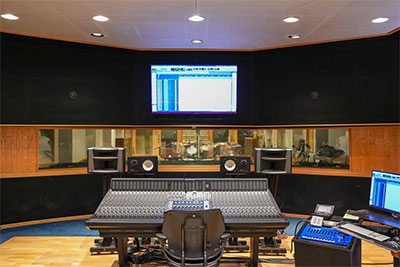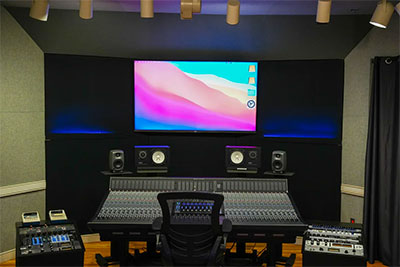Belmont University’s Mike Curb College of Entertainment & Music Business has taken two Solid State Logic Origin 32-channel analogue mixing consoles to serve as part of its Audio Engineering Technology programme. One console has been installed in the Robert E Mulloy Student Studios on Belmont’s main campus, and the other at Ocean Way Nashville Recording Studios.
Studio A in the Robert E Mulloy (REM) Studios and Studio B at Ocean Way Nashville both previously housed aging large-format analogue desks. ‘We had been needing to replace the consoles for a while,’ admits instructor Michael Janas, the Chair of Audio Engineering Technology (AET). While considering replacement options during the refurbishment of REM’s Studio A in 2019, he recalls, ‘The Origin was released, and I thought it looked interesting – and the value proposition looked really interesting.’
 The display console from the 2019 AES Show Origin launch had up found its way to the Nashville office of Vintage King Audio, one of SSL’s sales partners…
The display console from the 2019 AES Show Origin launch had up found its way to the Nashville office of Vintage King Audio, one of SSL’s sales partners…
‘I went over there and got on the console,’ says Janas, who has taught on six different desks over the years. ‘I brought up some tracks through it, listened and thought, for the size, for the layout and the sound, and how things are presented, it makes perfect sense to teach these classes on it.’
Although access to the recently installed desk at REM Studios has been limited by Belmont’s Covid-19 precautions, Janas did have an opportunity to check out Origin’s audio quality, while preparing for the imminent return to in-person tuition. ‘I spent four or five hours working on it, taking stuff I do on the curriculum and applying it to the Origin. Listening to a cue mix, for example, was not only very easy to do, it was also noticeably really punchy – much better sounding than the console we had in the room previously.’
Ocean Way Nashville, which Belmont University acquired in 2001, houses three rooms that are available for a mix of commercial and academic use. The new SSL console in Studio B has replaced an 11ft-wide, 96-input vintage console. ‘We have all this extra space so we can put chairs in there for students,’ says says Patrick McMakin, the facility’s Director of Operations. ‘So it worked out well.’
Studio B will be dedicated to Belmont’s AET program for the 2022 calendar year, he says, and will probably become available for commercial bookings again the following year.
A couple of Ocean Way Nashville’s staff engineers have given the Origin a workout on sessions prior to the new academic year starting, McMakin reports: ‘So far, I’m hearing great feedback. There’s a tendency to try and make this console do everything in the same way that the old console did, so we’re learning that new workflows are going to apply.’
Those workflows can be much more streamlined on the Origin compared to the AET programme’s previous desks, which included some complex routing options. When introducing Origin’s operation and workflow to some of his students off-campus recently, Janas says, ‘They were asking where the routing matrix is. I said, there’s that button and that button, referring to the Origin’s multitrack bus assignment system’
On Origin, any input may be assigned to a bus by pressing a bus master switch followed by the input channel’s Route switch. ‘And, you don’t have to do all those things you used to just to get a cue feed,’ Janas adds. ‘It’s very straightforward and easy to use.’
Janas and his students are also looking forward to getting familiar with a different metering scheme on the Origin. ‘We’re used to seeing peak or vu and something that is post fader on the channel.’

On the old console, he says, ‘If you brought a microphone in, you would switch the meters to look at the channel output, push the fader up and see how much level you had. Origin is interesting in that the channel meter comes directly after the channel input, so it’s metering what’s coming in, as opposed to what’s going out. It’s a different workflow, but it’s nice to have a meter that’s not a channel solo where you can see that.’
The Origin in REM’s Studio A replaced a 48-input desk with onboard patchbay that filled the control room wall to wall, he also reports. ‘One thing that’s nice with the SSL console only being about six feet wide is that now we’ve got Sound Construction Lowboy equipment racks on either side of it. The mic preamps and compressors, things that you want to grab quickly, especially in a tracking session, are right there close to you. Plus, we were able to mount the controls for the Lexicon reverbs and things like that on top of the racks.’
Belmont alumnus Robert Mulloy, who was appointed as a Director and Associate Dean while teaching at the school for more than 35 years, was a driving force behind the development of the Curb College’s music business and entertainment industry programmes.
‘What’s unique is this program started in the early 1970s because Robert Mulloy felt people should be educated about how the music business works,’ Janas says. ‘By the second year of the program they had started a studio class and a maintenance class, and out of that came the AET programme.’ The AET programme has grown to become one of the largest bachelor’s degree programs at Belmont University.
The Curb College’s Audio Engineering Technology program is the only ABET-accredited audio engineering technology degree programme in the world. ABET – the Accreditation Board for Engineering and Technology – accredits programs in applied and natural science, computing, engineering and engineering technology.
‘Not only does a student know that if they turn this knob the high-frequency goes up,’ Janas says. ‘They will also know the effect of it on the listener; they know what Q is and why it’s doing this in a particular way; and why a volume control is a log instead of a linear pot. All of those elements they learn in physics classes and the application of those concepts are taught in production and technology classes.’